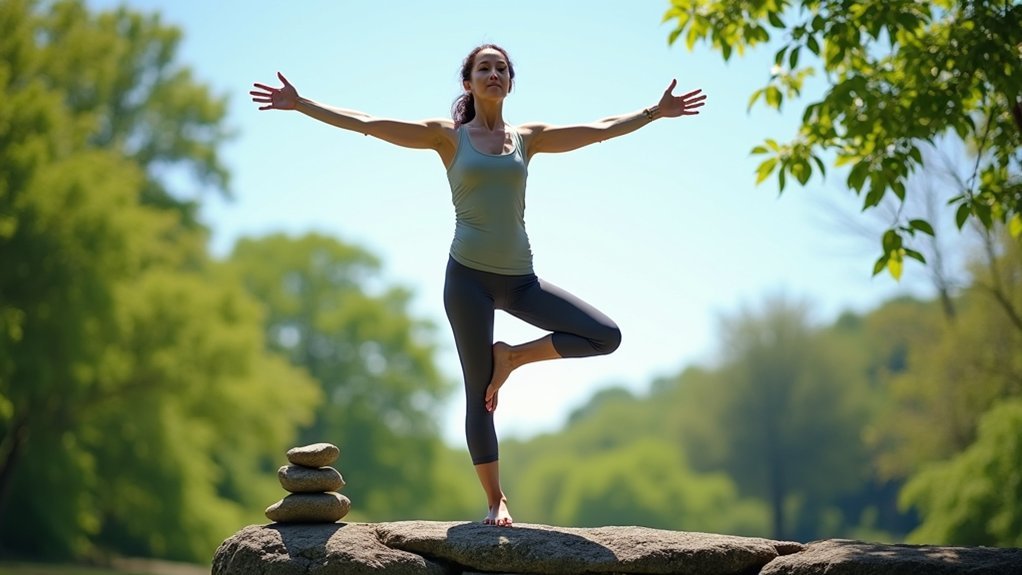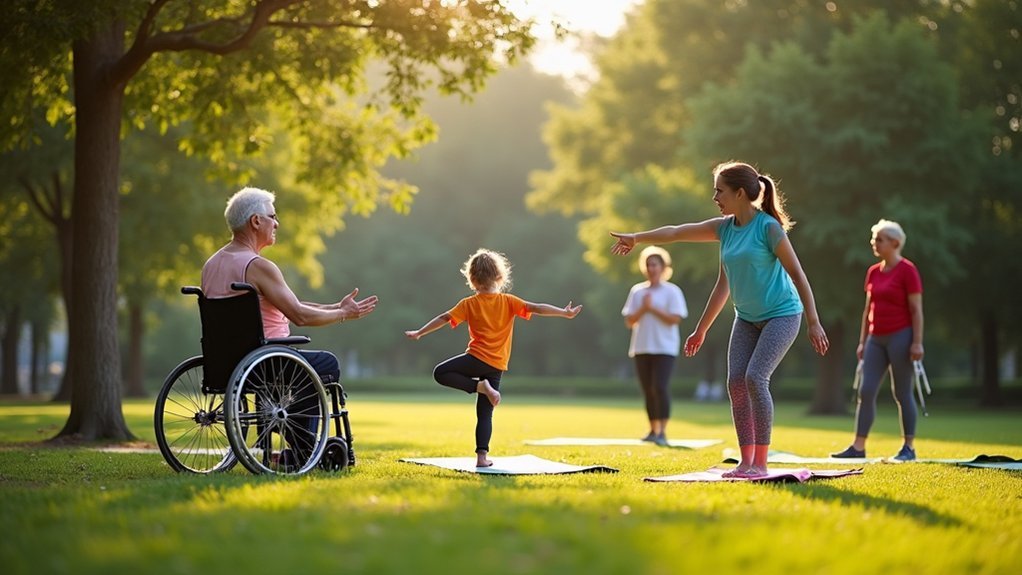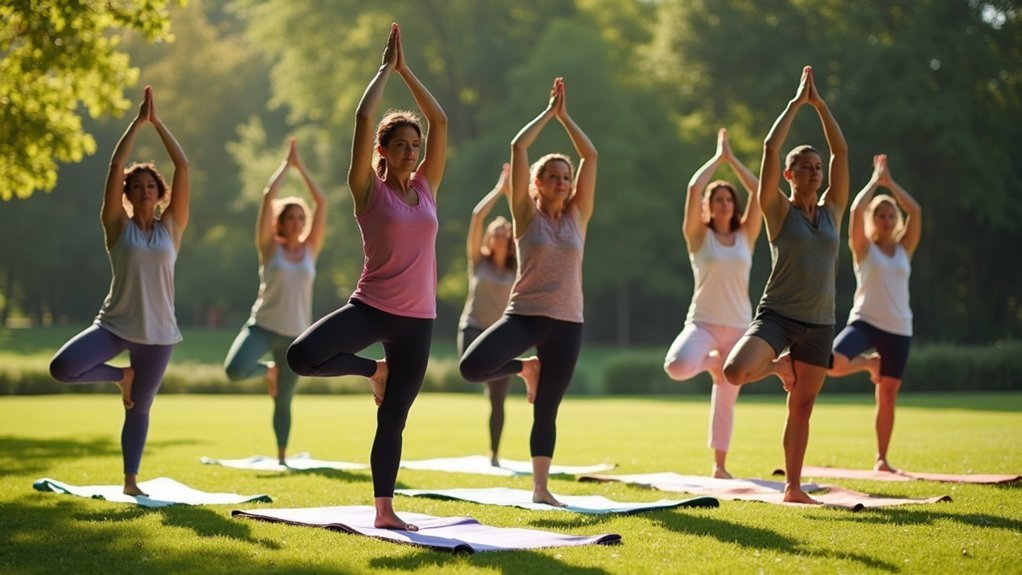Balance exercises do more than prevent falls—they heal the mind-body connection by fostering mindfulness and reducing anxiety. Practices like tree pose and warrior III improve core strength while enhancing proprioception and emotional regulation. You’ll benefit from synchronized breathing techniques that activate your parasympathetic nervous system, creating lasting calm. Start with supportive props if needed, then progress to more challenging positions. The journey toward balance brings physical stability and mental clarity that extends well beyond your practice time.
The Mind-Body Connection in Balance Training

While many people focus solely on the physical benefits of exercise, balance training offers a unique opportunity to strengthen the connection between mind and body. As you practice standing on one foot or moving through yoga poses, you’re not just improving stability—you’re enhancing cognitive function through focused concentration.
Balance training naturally cultivates mindfulness as you tune into your body’s subtle adjustments and alignment. You’ll notice your spatial awareness and coordination improving with consistent practice.
These exercises also reduce anxiety by engaging your mind in rhythmic, deliberate movements that calm your nervous system.
The confidence you gain from improved balance extends beyond physical stability. When you master challenging poses, you develop mental resilience that transfers to daily activities, creating a positive feedback loop between physical capability and mental well-being.
Foundational Balance Poses for Mental Wellness
Because your mind and body work in tandem, foundational balance poses offer a powerful gateway to mental wellness beyond physical stability. When you practice poses like tree pose and warrior III, you’re not just strengthening your core muscles—you’re cultivating mindfulness and mental clarity.
These balance exercises improve proprioception, enhancing your body’s awareness in space and boosting your confidence. As you hold these poses, you’ll naturally deepen your breathing, which helps regulate stress levels and improve emotional regulation.
Adding balance training to your regular fitness routine delivers cognitive benefits too, particularly as you age. The meditative state achieved through consistent practice creates a sense of calm that extends well beyond your workout.
Your mental wellness flourishes alongside your physical stability with each balanced breath.
Adaptive Balance Techniques for Different Abilities

Regardless of your physical abilities or limitations, balance training remains accessible through adaptive techniques that meet you exactly where you are.
If you’re dealing with mobility issues, you can utilize supportive equipment like chairs or walls during exercises, gradually building strength as your confidence grows.
For those with neurological conditions such as Parkinson’s disease, focus on slow controlled movements that enhance stability and coordination.
Begin with static positions before advancing to more challenging dynamic movements, adjusting difficulty levels to match your personal capacity.
Consider joining group classes designed for varied abilities—they provide social interaction while keeping you motivated in your balance practice.
These adaptive balance techniques guarantee everyone can experience the benefits of balance training, regardless of physical constraints.
Balance Tools and Props for Enhanced Stability
Enhancing your balance practice often requires the right tools to challenge and support your progress. Balance boards and stability balls are excellent options that heighten core engagement while improving overall stability during workouts.
For beginners, using props for support like chairs or walls can help you gradually build confidence as you develop your balancing skills.
To create more challenging conditions, try incorporating unstable surfaces with foam pads or wobble cushions, which force your body to recruit additional muscles for balance control. You can also add resistance bands to your routine, combining strength training with stability work for thorough results.
For a more dynamic balance challenge, Bosu balls offer versatility by testing both static and shifting positions, making your exercises more effective and engaging.
Mindful Movement Practices for Emotional Regulation

While balance training strengthens physical stability, mindful movement practices cultivate emotional equilibrium through the powerful mind-body connection.
Yoga and tai chi provide effective pathways to reduce anxiety as you learn to recognize emotional triggers through enhanced body awareness.
You’ll find these mindful movements naturally lower cortisol levels, diminishing the physical effects of stress while improving your resilience against emotional challenges.
By incorporating focused breathing techniques during physical activity, you’re actually rewiring your brain’s response to stressors while improving your overall mental health.
The beauty of mindful movement lies in its dual benefits—as you strengthen your physical form, you’re simultaneously developing tools for emotional regulation.
Regular practice creates a foundation of calm awareness that serves you both on and off the exercise mat.
Progressive Balance Challenges for Building Confidence
Starting with simple exercises like standing on one leg for a few seconds, you’ll gradually build your confidence through increasingly challenging balance activities.
You can track your progress by measuring how long you maintain each position or by noting improvements in your stability during daily movements.
As you celebrate these wins, incorporate mindfulness techniques such as focused breathing to strengthen the mind-body connection essential for mastering balance skills.
Start Small, Advance Gradually
The journey to better balance begins with simple, achievable steps rather than ambitious challenges that might lead to frustration or injury. Start small with single-leg stands or heel-to-toe walking to build your foundation and confidence in balance exercises.
As you improve stability, gradually increase intensity by shifting from static to dynamic activities. You’ll challenge the body more effectively when you incorporate variations like closing your eyes during exercises or adding movement while balancing.
Consistency is key—aim for at least 2-3 balance sessions weekly to monitor progress meaningfully. Track improvements such as longer hold times or completion of more complex exercises to reinforce achievement and motivate continued practice.
This methodical approach guarantees you’ll develop balance skills that truly support both your physical stability and confidence.
Track Progress, Celebrate Wins
Most people don’t realize how much their balance improves until they track it. Documenting your progress in balance exercises creates a visual representation of your journey and fuels motivation to continue. When you measure hold durations, repetition counts, and exercise difficulty, you’ll notice meaningful improvements that might otherwise go unrecognized.
Your balance training becomes more rewarding when you:
- Keep a journal that highlights each improvement, no matter how small
- Time your balance holds and celebrate when you add even a few seconds
- Challenge yourself with progressively complex exercises that build stability
- Regularly reassess your capabilities to acknowledge growth
This systematic approach to tracking progress transforms balance exercises from mere routines into achievements, creating a powerful sense of accomplishment that reinforces your commitment to continued stability training.
Mind-Body Connection Techniques
While many focus solely on the physical aspects of balance training, developing a strong mind-body connection dramatically enhances your stability practice and builds lasting confidence.
Try incorporating mindfulness techniques during balance exercises by focusing on your breath and posture. This approach not only improves physical stability but also reduces anxiety levels.
As you progress to more challenging activities like single-leg stands and heel-to-toe walking, you’ll notice enhanced body awareness that transfers to daily physical activity.
Research confirms that regular balance exercises improve cognitive function and memory, strengthening the link between physical and mental wellness.
When you gradually increase exercise complexity, you’ll experience a sense of achievement that boosts self-esteem. Setting specific goals and tracking progress fuels motivation and creates a positive mindset—essential elements for maintaining both physical stability and mental health.
Balance Exercises for Anxiety and Stress Reduction
Beyond their physical benefits, balance exercises offer powerful tools for managing anxiety and stress in your daily life.
By incorporating practices like tai chi and yoga, you’re not just improving coordination—you’re actively engaging in mindfulness that promotes deep relaxation through controlled movements and conscious breathing.
Regular balance training enhances your body awareness and proprioception, which directly contributes to decreased anxiety symptoms—some studies show reductions of up to 30%.
These exercises become a therapeutic outlet in your daily routine, providing structure and mental clarity when you need it most.
Try these anxiety-busting balance activities:
- Morning tai chi to stimulate endorphin production
- Single-leg balance poses to enhance your sense of control
- Slow yoga shifts to practice mindful movement
- Balance board exercises to improve emotional well-being
Partner-Assisted Balance Activities for Social Connection
Partner-assisted balance activities offer powerful ways to strengthen both your physical stability and social connections.
Try supportive standing poses where you and a partner face each other, hold hands, and lean back while maintaining balance, creating mutual trust and accountability.
Mirroring movement games, where you match your partner’s actions in real-time, enhance coordination while fostering nonverbal communication and deepening your interpersonal bond.
Supportive Standing Poses
When you share balance exercises with someone else, you create more than just physical stability—you build meaningful connections.
Partner-assisted balance activities, particularly supportive standing poses, strengthen your physical foundation while enhancing social bonds through teamwork and communication.
These balance exercises contribute to your overall mental well-being by:
- Creating opportunities for meaningful interaction that reduces feelings of isolation
- Building trust as you rely on each other’s support while exploring your balance abilities
- Increasing your motivation to maintain consistent practice through shared accountability
- Fostering a sense of community and belonging that strengthens emotional health
Research shows you’re more likely to stick with balance training when working with a partner, making these exercises beneficial for both stability and social connections.
Mirroring Movement Games
Mirroring movement games take partner-assisted balance to a new level by combining coordination with social connection. As you mirror your partner’s movements, you’re simultaneously improving proprioception and enhancing body awareness through focused attention on matching their actions.
These partner-assisted balance exercises create a sense of teamwork that naturally boosts your motivation to engage in physical activity. You’ll find yourself looking forward to practice as the social interaction elevates your mood and makes the experience more enjoyable than solo exercises.
This approach is particularly valuable for older adults who benefit both physically and emotionally from the shared experience. By transforming balance training into an interactive social activity, you’re more likely to maintain consistency—making these mirroring games not just fun but remarkably effective for long-term balance and coordination development.
Environmental Modifications for Safe Balance Practice
Creating a safe environment for balance exercises greatly reduces your risk of injury and enhances training effectiveness. Before beginning your balance exercises, assess the environmental factors that might increase fall risk. Physical therapy experts recommend you clear clutter completely from your space for balance activities.
For ideal safety during practice:
- Guarantee bright, consistent lighting throughout your exercise area to help your brain accurately process spatial information.
- Position sturdy chairs or stable furniture within reach to provide immediate support if you feel unsteady.
- Install non-slip mats in areas where you’ll be performing standing exercises to prevent dangerous slips.
- Remove hazards like loose rugs, electrical cords, or low furniture that could catch your foot during movement.
Integrating Breath Work With Balance Training
The connection between breath and balance forms a powerful foundation for effective stability training. When you synchronize your breathing with movement, you’ll enhance your proprioception—the body’s awareness of its position in space—resulting in improved balance and coordination.
Try inhaling deeply as you prepare for balance exercises and exhaling as you execute them. This technique activates your parasympathetic nervous system, promoting relaxation while maintaining concentration during challenging stability work. Research shows this mindful approach particularly benefits older adults by reducing fall risk.
Regular integration of breath work into your balance training strengthens your mind-body connection, clearing mental fog and reducing stress.
You’ll notice improvements not just in physical balance but also in mental clarity as you learn to harness the calming power of controlled breathing.
Tracking Progress: Celebrating Small Victories in Balance
As you begin your balance training journey, documenting your progress becomes essential for sustained motivation and growth. Maintain a journal of balance exercises to reinforce accountability while tracking improvements in your stability.
Set specific goals, such as mastering one new balance exercise monthly, to recognize advancements and celebrate milestones along the way.
Visual evidence provides powerful motivation to improve balance through consistent practice:
- Time your balance holds, aiming to increase duration by 5+ seconds each week
- Record videos of your technique to identify subtle improvements
- Note which exercises have progressed from challenging to comfortable
- Document emotional changes—increased confidence, reduced fear of falling
Celebrating these small victories fuels your commitment to balance training and acknowledges your body’s remarkable adaptability.
Frequently Asked Questions
What Is the Best Exercise to Regain Balance?
Single-leg stands are your best exercise to regain balance. They engage your core and lower body muscles while improving stability. You’ll benefit most from practicing them 2-3 times weekly with support as needed.
Are Balance Exercises Good for the Brain?
Yes, balance exercises are excellent for your brain. They strengthen neural connections, improve cognitive function, boost memory, enhance concentration, and may reduce your risk of cognitive decline as you age.
What Is the Number One Balance Exercise for Seniors?
The number one balance exercise for seniors is the single-leg stand. You’ll strengthen your core and improve stability by balancing on one foot for up to 30 seconds, reducing your fall risk considerably.
What Is the Best Therapy for Balance?
The best therapy for balance usually combines physical exercises that build core strength with practices like Tai Chi or vestibular rehabilitation. You’ll benefit most from a personalized approach that addresses your specific balance challenges.
In Summary
You’ve now discovered powerful ways to heal both physically and mentally through balance work. As you continue your practice, you’ll notice improvements in stability, focus, and emotional resilience. Remember that balance isn’t just physical—it’s a holistic journey connecting mind, body, and spirit. Be patient with yourself, celebrate small wins, and trust that your consistent efforts are transforming your wellbeing from the inside out.





Leave a Reply